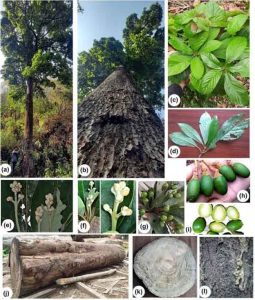Biodiversity hotspots are the regions considered to exhibit a high level of endemism of the native species. Since Manipur maintains a large number of endemic species, it is one of few states in North East India where the boundaries of two biodiversity hotspots (i.e., Himalaya (Eastern-Himalaya) and Indo-Burma) overlap. Manipur, with a total geographical area of 22327 km square, maintains 77% of the area under forest cover (SFR (State of Forest Report) 2021), including Tree Outside Forest (TOF), with 74.34% recorded forests. Manipur has a total recorded forest area (RFA) of 17,418 sq. km, out of which 984 sq. km comes under Reserve Forest (RF), 3,254 sq. km under Protected Forest (PF), and 13,180 sq. km under unclassed forest. In terms of forest canopy density classes, the state has 905 sq. km under very dense forest (VDF), 6,228 sq. km under moderately dense forest (MDF), and 9,465 sq. km under open forest (OF). The database on tree diversity, Global Tree Search (GTS), reported 3708 tree species in India, of which 877 tree species (23.65%) are found in Manipur. Among these tree species of Manipur, 609 (69.44%) are endemic, and 347 (39.56%) are in the threatened category of IUCN’s Red Data List.

Data shows that roughly 40% of the state’s endemic trees have already been vulnerable to different selection pressures. In recent years, the forests of the state, harbouring unique genetic diversity of forest resources, have been facing critical threats due to anthropological pressures, for example, expansion of the population, jhum or shifting cultivation, conversion of forests for non-forestry purposes like infrastructure development etc., and warming due to global climate change. SFR (2021) reported roughly 500 km square of forest cover reduction by the state compared to the 2019 assessment. Global Forest Watch reported a loss of 13.9 ha of natural forest equivalent to 7.97 Mt of CO2 emissions in Manipur in the year 2023 only.
In the 2011 census, Manipur had a population of 27.71 Lakh, showing a 4.8% growth from the 1951 population of 5.77 Lakh. As the population rises, the demand for different forest resources also rises, leading to the conversion of forest area for agriculture through Shifting Cultivation with a reduced rotation period due to limited agricultural land. Encroachment for settlement or conversion for agriculture in the Reserve Forest and Protected Forests such as National Park, Wildlife Sanctuaries, wetlands, etc., increases the risk of forest fire, disease and invasive species. Introducing exotic species in the state for different purposes will lead to the possibility of becoming invasive species, like para grass, considered good fodder plants for cattle. Still, it becomes a menace in the Keibul Lamjao National Park area, restricting the growth of natural fodder plants. In the 2021 report from FSI, it was stated that 90% of Manipur’s total forest cover area is at high risk of forest fires. Developmental works like Border Fencing in the Indo-Myanmar boundary and construction of the Jiribam Tupul Railway Line in the Western Forest Division will lead to the fragmentation of species populations that restrict species from migration. The resilience of the forest ecosystem is at risk due to shifting cultivation, invasive species, forest fires and developmental projects, which hinder forest tree species’ ability to adapt to changing environmental conditions. Forest destruction and species extinction are significant consequences of climate change and excessive human interference.

The latest amendment (2023) of the Forest Conservation Act (1980) exempts all strategic linear projects of national importance and concerning national security within 100 km of the international border, the line of actual control (LAC), and the line of control (LOC). Being a state of India on the International border, Manipur shares a 352 km long stretch of land with Myanmar in the southeast. In execution of the regulation from the FCA (amendment), covering 100 km radius along the international border, all forests of the state may be converted for roads, railways, and army-supporting infrastructures. Therefore, all the forest genetic resources of the state are vulnerable to extinction and may be compromised for national security projects, military purposes, small roadside amenities, and public roads. The forest area along this Indo-Burma border had already been fragile due to widespread forest destruction for logging, mining, gems and ore, firewood collection, and charcoal production.
Traditional knowledge of ethnobotanical uses of tree species is high as the state comprises different tribes and ethnic groups. Lack of use and documentation of tree species may lead to the unavoidable extinction of species as many endemic species were underrepresented in Manipur. Trees, forests, and their genetic resources will have an essential and central role in helping to limit rises in atmospheric carbon and slow climate change impact through sequestration and storage of atmospheric carbon. Knowing the genetic variation of species is necessary to conserve the species. Understanding forest genetic diversity is very important for conserving forest tree species. Genetic diversity provides the basis for forest tree species’ evolution and adaptation to the changing environment. The intra-specific diversity of many tree species has facilitated their survival and adaptation to diverse environments, including climate variability over hundreds of millennia. These diversities relate to the mounting evidence for the adverse effects of climate change on forests, both through direct (temperature, rainfall, etc. effects on trees themselves) and indirect (e.g., increased pest, disease, and fire incidence). High extant genetic diversities and the enormous quantity of seed produced by out-crossed parent trees support adaptive responses to climate. These genetic diversities ensure forest trees survive, adapt, and evolve under changing environmental conditions. Maintaining the genetic diversity is necessary for the survival and health of the species in the changing environment. Moreover, the conservation of genetic diversity within the population of wild and domesticated species is one of the goals of the latest framework of the UN Convention on Biological Diversity (COP 15, 2022) signed by India with a commitment goals to the Kunming-Montreal protocol.
Therefore, it is high time for Manipur to prioritise their native and endemic tree species for conservation to compensate for the genepool loss that may be caused due to the implementation of the latest amendment of the Forest (Conservation) Act. The researchers should actively document the ethnobotanical utilisation pattern of forest tree species among all tribes and ethnic groups. For the latest, there is only one National park and one wildlife sanctuary in the state. There is a need to develop strict nature reserves to conserve specific species in their natural habitat. To fulfil the requirement of the seeds for reforestation, afforestation and ecological restoration, there is a need to demarcate Seed Production Areas, and establish seed orchards and seed gene banks of native forest species. The state requires more forests to be designated under national parks and sanctuaries. Fire-tolerant native trees may be selected to plant in fire-prone forests. In all this effort, the role of forest dwellers may also be signified by maintaining the information on species and genetic diversity of forest trees in the People’s Biodiversity Register. Such an initiative may help to move ahead with the long-term goal of conserving the diversity of state endemic forest genetic resources.

Picture- The state tree of Manipur Uningthou (Phoebe bootanica) is one of the threatened tree species, rare in sighting, and requires rigorous restoration initiative. The picture depicts a. tree in the wild, b. tree trunk with branching, 3. Leaves, 4. Phyllotaxy, e – g. floral buds, h-i. fruits, j-k. wood, l. bark, of the tree
Author:
Thounaojam Monika (M.Sc. Intern) and Neekee Thangjam (PhD Scholar) in the Laboratory for Conservation & Genetic Improvement of Forest Trees, Department of Forestry, School of Agriculture Science, Manipur University
Corresponding Author – neekeeethangjam404@gmail.com













